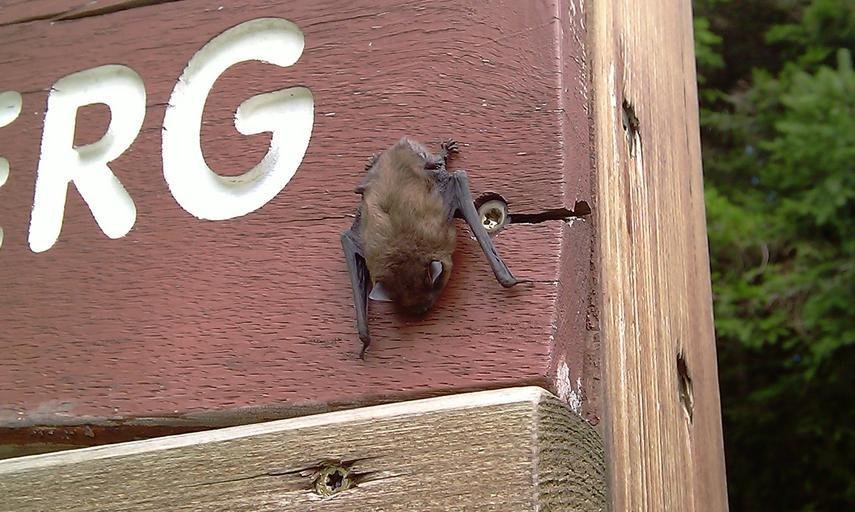Keen’s Myotis: Myotis Keenii

Physical Characteristics Of Keen’s Myotis
Keen’s Myotis is a smaller bat similar to the Little Brown Bat in size and appearance. With a wingspan of 23 to 26 cm, it weighs between 6 and 9 grams.
This bat has a 26 mm long tail, and its’ average length is 78 mm. With dark patches on its shoulders, Keen’s Myotis has short brown fur on his body. Other distinguishable physical characteristics include thumbs with a claw, small eyes, and complex ears that are distinctive. 1Go To Source uwsp.edu -“Myotis Keenii – Keen’s Myotis”
Learn More: Rare Bat Species
Keen’s Myotis Behavior
M. Keenii appears to be a social creature, by all accounts. There were approximately 30 to 40 females in the studied maternity roosts, and hibernacula were similarly documented as a residence for large colonies of bats, including other bat species.
They are nocturnal, but at dusk and dawn, they may be active. During the winter, Myotis keenii hibernates and becomes torpid during daytime roosting.
This bat species tends to remain relatively close to favored roosting sites, and limited studies and accounts involving keen’s myotis showed the estimated daily travel time is less than 1 kilometers.
There have also been documented evidence that these bats return to particular foraging areas year after year, although their specific roosting and foraging range sizes have not been determined. Also, it was suggested that this bat would conduct short migrations between summer and hibernation. 2Go To Source animaldiversity.org -“Myotis keenii Keen’s myotis”
Keen’s Myotis Reproduction Habits
The breeding habits of Keen’s myotis are little known. Limited proof suggests in autumn, M. keenii mates and gives birth the following June or July to a litter of one.
Females select warm roost sites with stable microclimates for day-roosting in temperate climates, which reduces thermoregulation requirements. This helps reproductive females prevent or decrease the use of torpor during juveniles’ fetal development.
During bad weather, bats often enter torpor to conserve energy, but this delays juvenile and fetal development and inhibits milk production. Females provide their youngsters with milk and protection until they become independent, usually by late August.
Torpor takes place when M. keenii enters a decreased physiological activity state by reducing its metabolic rate and body temperature. Torpor can happen daily during the winter months. 3Go To Source adfg.alaska.gov -“Keen’s Myotis (Myotis keenii) Species Profile”
Habitat Of Keen’s Myotis
Typical roosting associations are cool, wet, coastal montane forests and Karst cave features. Tree cavities, bark, and rock crevices, and caves more than 100 m long and above 400 m elevation with stable temperatures of 2.4-4 ° C and 100 percent humidity are important habitat characteristics.
Foraging covers a wide range of open areas, ranging from intertidal areas and estuaries to upland forest clearings, peripheral areas, wetlands, and freshwater riparian areas.
Typically, forage and roost buffer requirements are between 30 and 50 half acres but depend on site-specific variables, including the type of feature (cave vs. tree), roosting trees location, wetlands, or lakes potential presence corridors of movement. 4Go To Source sccp.ca -“Keen’s Myotis”
Keen’s Myotis Range
The keen’s myotis bat is one of the smallest bat populations in North America. They have been seen in mainly coastal areas from southeast Alaska to Washington state.
The size of the population and trends are unknown. In general, they are considered rare, but field identification problems complicate efforts to evaluate populations. In British Columbia and southeast Alaska, low densities have been identified. 5Go To Source wdfw.wa.gov -“Keen’s myotis (Myotis keenii)”
Keen’s Myotis Diet
This bat feeds on a large variety of flying insects between the shrub layer and canopy of the forest. Often it forages over ridges and hillsides, and some insects can be gleaned from the trees’ foliage. Just after dusk and before dawn, the feeding flights are the longest.
Insects Eaten By Keen’s Myotis
- Beetles
- Lacewings
- Moths
- Caddis Flies
- Mayflies
Threats To The Keen’s Myotis Bat Species
- This species is vulnerable to habitat loss due to logging and other resource extraction practices due to the dependence on tree cavity roosts associated with intact mature forest stands and forested karst cave sites used for breeding hibernation.
- Alteration of sensitive micro-climate conditions of humidity and temperature in caves from intensive recreational caving, mineral exploration, and White-nosed syndrome; a fungal pathogen that is potentially spread by human activities
- From the application of pesticides used to control insect pests in silviculture/agricultural pest control practices, prey loss due to pesticide build up in the food chain, many of which may be part of the bat’s diet. 6Go To Source sccp.ca -“Keen’s Myotis Myotis keenii”
Sources:
- “Myotis Keenii – Vertebrate Collection.” UWSP, 04-04-28, www.uwsp.edu/biology/VertebrateCollection/Pages/Vertebrates/Mammals%20of%20Wisconsin/Myotis%20Keenii/Myotis%20Keenii.aspx.
- Filla, J. 2005. “Myotis keenii” (On-line), Animal Diversity Web. Accessed January 05, 2021 at https://animaldiversity.org/accounts/Myotis_keenii/
- “Keen’s Myotis | Washington Department of Fish & Wildlife.” Washington Department Of Fish And Wildlife, wdfw.wa.gov/species-habitats/species/myotis-keenii#conservation. Accessed 5 Jan. 2021.
- Zevit, Pamela. “Keen’s Myotis.” South Coast Conservation Program, June 2017, www.sccp.ca/species-habitat/keens-myotis.
- ADFG. “Keen’s Myotis Species Profile, Alaska Department of Fish and Game.” Alaska Department Of Fish And Game, www.adfg.alaska.gov/index.cfm?adfg=keensmyotis.main. Accessed 5 Jan. 2021.
